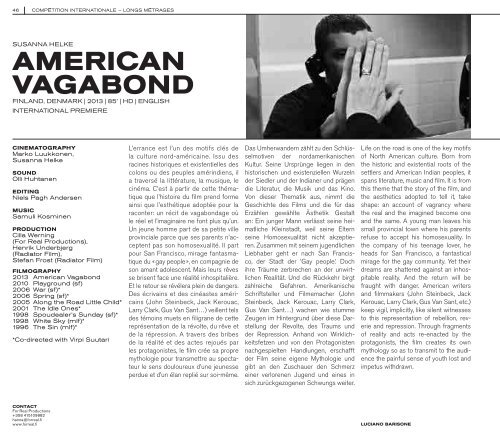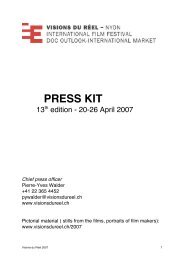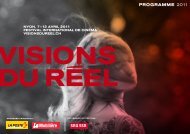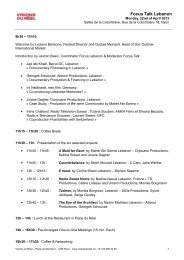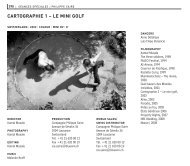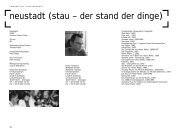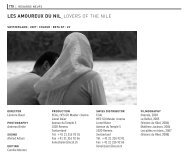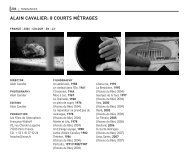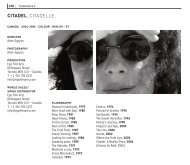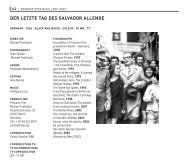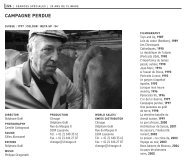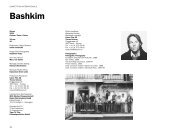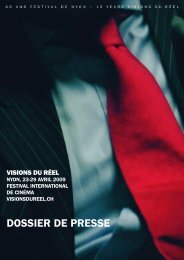Katalog 2013.pdf - Visions du Réel
Katalog 2013.pdf - Visions du Réel
Katalog 2013.pdf - Visions du Réel
You also want an ePaper? Increase the reach of your titles
YUMPU automatically turns print PDFs into web optimized ePapers that Google loves.
46 compétition internationale – longs métrages<br />
Susanna Helke<br />
American<br />
Vagabond<br />
Finland, Denmark | 2013 | 85’ | HD | English<br />
International Premiere<br />
Cinematography<br />
Marko Luukkonen,<br />
Susanna Helke<br />
Sound<br />
Olli Huhtanen<br />
Editing<br />
Niels Pagh Andersen<br />
Music<br />
Samuli Kosminen<br />
Pro<strong>du</strong>ction<br />
Cilla Werning<br />
(For Real Pro<strong>du</strong>ctions),<br />
Henrik Underbjerg<br />
(Radiator Film),<br />
Stefan Frost (Radiator Film)<br />
Filmography<br />
2013 American Vagabond<br />
2010 Playground (sf)<br />
2006 War (sf)*<br />
2006 Spring (sf)*<br />
2005 Along the Road Little Child*<br />
2001 The Idle Ones*<br />
1998 Spoudealer’s Sunday (sf)*<br />
1998 White Sky (mlf)*<br />
1996 The Sin (mlf)*<br />
*Co-directed with Virpi Suutari<br />
L’errance est l’un des motifs clés de<br />
la culture nord-américaine. Issu des<br />
racines historiques et existentielles des<br />
colons ou des peuples amérindiens, il<br />
a traversé la littérature, la musique, le<br />
cinéma. C’est à partir de cette thématique<br />
que l’histoire <strong>du</strong> film prend forme<br />
ainsi que l’esthétique adoptée pour la<br />
raconter: un récit de vagabondage où<br />
le réel et l’imaginaire ne font plus qu’un.<br />
Un jeune homme part de sa petite ville<br />
provinciale parce que ses parents n’acceptent<br />
pas son homosexualité. Il part<br />
pour San Francisco, mirage fantasmatique<br />
<strong>du</strong> « gay people », en compagnie de<br />
son amant adolescent. Mais leurs rêves<br />
se brisent face une réalité inhospitalière.<br />
Et le retour se révélera plein de dangers.<br />
Des écrivains et des cinéastes américains<br />
(John Steinbeck, Jack Kerouac,<br />
Larry Clark, Gus Van Sant…) veillent tels<br />
des témoins muets en filigrane de cette<br />
représentation de la révolte, <strong>du</strong> rêve et<br />
de la répression. A travers des bribes<br />
de la réalité et des actes rejoués par<br />
les protagonistes, le film crée sa propre<br />
mythologie pour transmettre au spectateur<br />
le sens douloureux d’une jeunesse<br />
per<strong>du</strong>e et d’un élan replié sur soi-même.<br />
Das Umherwandern zählt zu den Schlüsselmotiven<br />
der nordamerikanischen<br />
Kultur. Seine Ursprünge liegen in den<br />
historischen und existenziellen Wurzeln<br />
der Siedler und der Indianer und prägen<br />
die Literatur, die Musik und das Kino.<br />
Von dieser Thematik aus, nimmt die<br />
Geschichte des Films und die für das<br />
Erzählen gewählte Ästhetik Gestalt<br />
an: Ein junger Mann verlässt seine heimatliche<br />
Kleinstadt, weil seine Eltern<br />
seine Homosexualität nicht akzeptieren.<br />
Zusammen mit seinem jugendlichen<br />
Liebhaber geht er nach San Francisco,<br />
der Stadt der ’Gay people’. Doch<br />
ihre Träume zerbrechen an der unwirtlichen<br />
Realität. Und die Rückkehr birgt<br />
zahlreiche Gefahren. Amerikanische<br />
Schriftsteller und Filmemacher (John<br />
Steinbeck, Jack Kerouac, Larry Clark,<br />
Gus Van Sant…) wachen wie stumme<br />
Zeugen im Hintergrund über diese Darstellung<br />
der Revolte, des Traums und<br />
der Repression. Anhand von Wirklichkeitsfetzen<br />
und von den Protagonisten<br />
nachgespielten Handlungen, erschafft<br />
der Film seine eigene Mythologie und<br />
gibt an den Zuschauer den Schmerz<br />
einer verlorenen Jugend und eines in<br />
sich zurückgezogenen Schwungs weiter.<br />
Life on the road is one of the key motifs<br />
of North American culture. Born from<br />
the historic and existential roots of the<br />
settlers and American Indian peoples, it<br />
spans literature, music and film. It is from<br />
this theme that the story of the film, and<br />
the aesthetics adopted to tell it, take<br />
shape: an account of vagrancy where<br />
the real and the imagined become one<br />
and the same. A young man leaves his<br />
small provincial town where his parents<br />
refuse to accept his homosexuality. In<br />
the company of his teenage lover, he<br />
heads for San Francisco, a fantastical<br />
mirage for the gay community. Yet their<br />
dreams are shattered against an inhospitable<br />
reality. And the return will be<br />
fraught with danger. American writers<br />
and filmmakers (John Steinbeck, Jack<br />
Kerouac, Larry Clark, Gus Van Sant, etc.)<br />
keep vigil, implicitly, like silent witnesses<br />
to this representation of rebellion, reverie<br />
and repression. Through fragments<br />
of reality and acts re-enacted by the<br />
protagonists, the film creates its own<br />
mythology so as to transmit to the audience<br />
the painful sense of youth lost and<br />
impetus withdrawn.<br />
Contact<br />
For Real Pro<strong>du</strong>ctions<br />
+358 415109882<br />
hanna@forreal.fi<br />
www.forreal.fi<br />
Luciano Barisone


